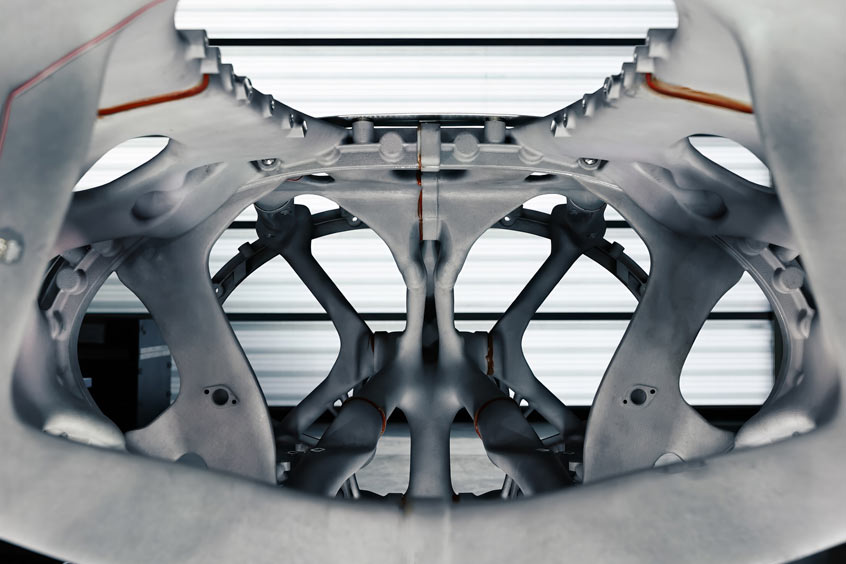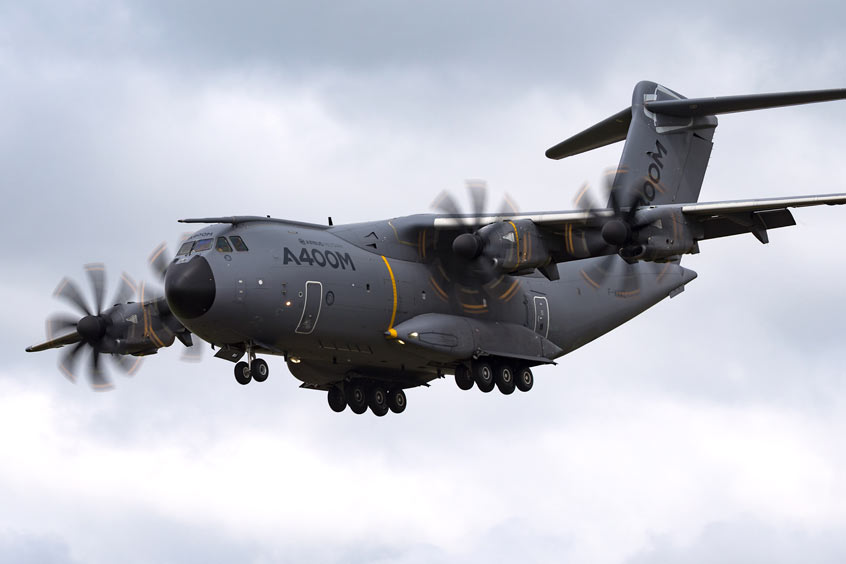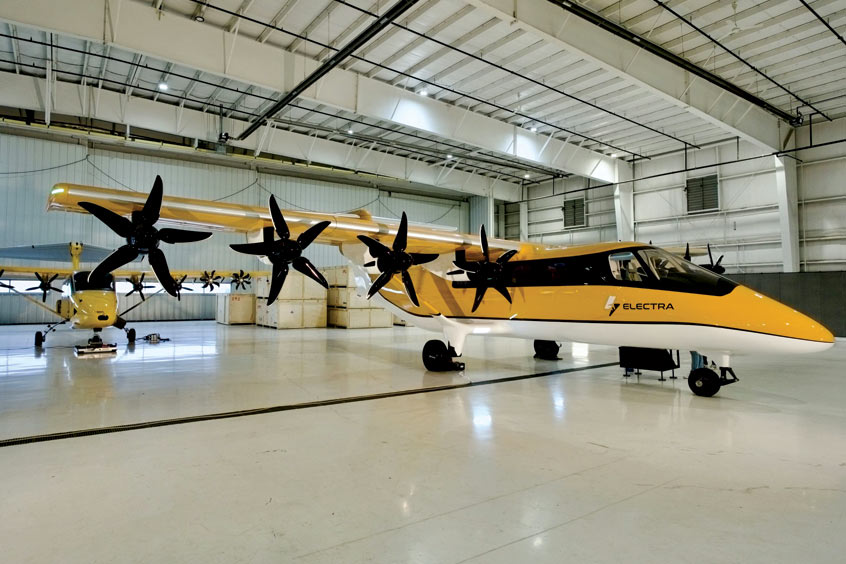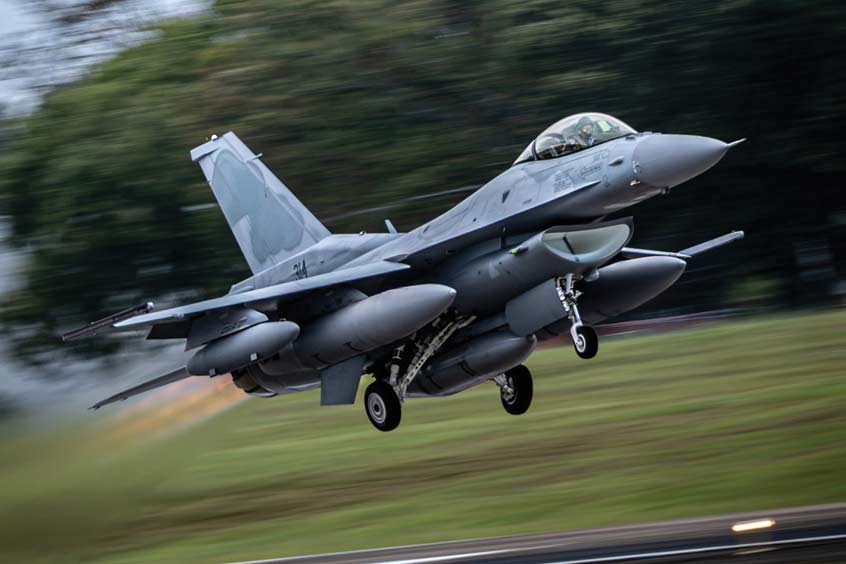For decades, aluminium has predominated in the construction of aircraft, with production continuously optimised over that time. However, this approach is no longer sufficient for sustainable, climate-friendly air transport. New solutions are needed at all levels to make the air travel industry more sustainable. The German Aerospace Center, in collaboration with Premium AEROTEC, Airbus and Aernnova, has now demonstrated that a revolution is achievable when it comes to materials and production. Together, the partners have developed a fuselage component made entirely of carbon-fibre-reinforced thermoplastic. The special plastic (LM_PAEK) makes the component less vulnerable to damage and approximately one tonne lighter than its aluminium counterpart. Radically new technologies have been developed for production and assembly, enabling cost-effective, resource-efficient processes with minimised energy consumption.
MFFD – Multifunctional Fuselage Demonstrator
A fuselage half-shell – the upper half of an aircraft fuselage – was manufactured at DLR in Augsburg in order to investigate the material used and demonstrate the necessary technologies. The prototype, referred to as the Multifunctional Fuselage Demonstrator (MFFD) is eight metres long and was developed as part of the Large Passenger Aircraft Programme within the European Clean Sky 2 research initiative. The aim is to reduce aircraft fuselage weight by 10 percent and operating costs by 20 percent, with a view to a production rate of 60 to 100 aircraft per month. On 18 July 2023, the MFFD project partners successfully delivered the upper shell.
"In order to achieve climate-friendly flight, the efficiency of current aircraft must be doubled by the middle of this century – by means of lightweight system construction, among other approaches," says Markus Fischer, DLR's Divisional Board Member for Aeronautics. "The upper fuselage shell made of fibre-reinforced thermoplastics that has now been manufactured at DLR in Augsburg is a promising milestone and unprecedented in its size."
Thermoplastics, or thermoplastic Carbon-Fibre-Reinforced Polymers (CFRP), have special properties. While they retain their stable form when cooled, they can be reshaped if heat is reapplied within a certain temperature range. This means that components can be repaired and recycled much more effectively than before. The design for the thermoplastic CFRP upper shell was devised by Premium AEROTEC, in collaboration with the other project partners. The automated production and robotic tools were mainly developed at the DLR Center for Lightweight Production Technology in Augsburg. The researchers have brought three essential technologies to maturity – laser-based in-situ fibre placement, continuous ultrasonic welding and electrical resistance welding.
Lasers, ultrasound and electrical current
To produce the outer skin of the aircraft, the DLR team used a robot suspended upside down, which used a laser to precision-heat the strips of material and apply them in layers, creating a laminate of fibre-reinforced plastics. Material wastage is minimal, so the system is resource efficient. This is important when it comes to balancing costs, as CFRP is considerably more costly than aluminium. Subsequent curing in an autoclave, which is necessary for aircraft components made of carbon-reinforced composites, is no longer necessary. This shortens the production time by up to 40 percent and thus further reduces costs.
In the next production step, the outer skin had to be fitted with longitudinal stiffeners. Instead of riveting the 44 stringers, they were ultrasonically welded onto the component – a world first. To do this, the ZLP team had a robot move along the stringers with high-precision automatic path correction. This method is significantly faster than the conventional mechanical process. Like the subsequent joining technology, it boasts the advantage of producing no swarf or dust, so components can be pre-assembled, and the fuselage shells need not be connected together until final assembly. With metal construction, swarf could damage the hydraulics, electrics or other installations in the aircraft fuselage.
The third technology that the DLR team has developed relates to the installation of the transverse stiffeners. The ribs were heated using an electrical current and resistance-welded using a specially developed tool. The process is extremely robust and delivers the highest weld strengths. Compared to aluminium, thermoplastic CFRP reduces the production time and thus the manufacturing costs. Since there are no holes, the load-bearing aircraft skin remains intact and dust-free.
The Augsburg team augmented the resistance welding process to connect the longitudinal stiffeners to the crossmembers. As this work is highly detailed and performed in extremely cramped conditions, they combined the standard robot with a small lightweight robot. The flexibly controlled 'cobot' was able to automatically align itself with the frames and stringers and weld the dozens of connecting elements quickly and accurately.
Plans and potential
"It was a highly challenging project, both professionally and for me personally," says DLR Project Manager Frederic Fischer of the ZLP. "Within just a few years, our work on the MFFD upper shell has resulted in possible alternatives to technologies that have proven themselves over decades in aeronautics. I am excited about the coming steps, yet confident that we are on the right track, as lightweight construction is set to become even more important for future air transport."
With the MFFD, DLR has succeeded in producing the world's largest aircraft component made of fibre-reinforced thermoplastics. The technologies developed in the project have been significantly increased in maturity and are characterised by a very low ecological footprint. DLR is thus making a significant contribution to climate-friendly flight. As the current project shows, the ZLP in Augsburg has achieved the best foundations for developing the next generation of aircraft. This technology demonstration boosts competitiveness at regional, national and European levels.
Since mid-June, the fuselage half-shell has been at the premises of project partner Premium AEROTEC, which finalised the finishing stage and installation of the door frame at their Augsburg facility. Following successful delivery, the component is now being transported to the Fraunhofer Institute for Manufacturing Technology and Advanced Materials in Stade, where it will be joined with a lower shell from the Netherlands (STUNNING project) to form a complete fuselage shell section by the end of the year. Airbus will then perform the final validation and verification of the technologies at the Center of Applied Aeronautical Research in Hamburg.
| Contact details from our directory: | |
| DLR - German Aerospace Center | Fuel Cells, Testing Services, Research/Consulting Services, Composite Design Consultants, Flight Simulators, Instrument Landing Systems, Prototyping, Airframer, Vibration Testing |
| Premium AEROTEC GmbH | Fuselage Sections, Aircraft Flooring, Aircraft Doors, Flap/Slat Mechanisms, Aircraft Structural Components, Prototyping, Aircraft Interior Bulkheads, Aircraft Landing Gear, Final Assembly, Plant Automation Equipment, Additive Manufacturing |
| Airbus S.A.S. | Airframer |
| Aernnova Aerospace | Aircraft Structural Components, Metal Structures, Ceramic Composite Structures, Aircraft Control Surfaces, Wings, Fuselage Sections, Empennages, Nacelles, Fairings, Engine Housings, Aircraft Interiors, Helicopter Assemblies, Technical Manuals |
| Fraunhofer Institute for Manufacturing Technology & Advanced Materials - IFAM | Research/Consulting Services |
| ZAL Center of Applied Aeronautical Research | Research/Consulting Services |
| Related directory sectors: |
| Design |
Weekly news by email:
See the latest Bulletin, and sign up free‑of‑charge for future editions.

Saab advances digital manufacturing with autonomous fuselage

Airbus deploys Stratasys printed parts for A320, A350 and A400M

Electra kicks off Part 23 application for hybrid-electric EL9
